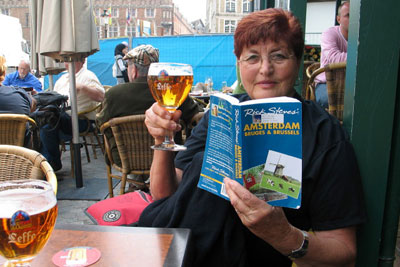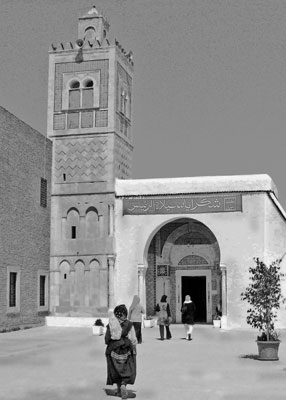Most useful guidebooks
ITN asked, “When planning for a trip outside of the US, which guidebook publisher do you look to for information and why?” Along with naming the guidebook and publisher, we requested that your response include approximately when you took the corresponding trip and where. A number of letters were printed in the September and October 2009 issues, but this topic generated a few more, presented here.
My husband, Richard, and I travel independently as well as on tours. Many times we’ve done a combination of both on the same trip. It depends on where we’re going. We have traveled to more than 90 countries on ITN’s Official List of Nations.
My main reason for buying guidebooks is to learn about the history, culture and customs of the area I will be visiting. There is also information on the foods, products, etc., unique to the area plus practical information about transportation, the climate and the best way to exchange money.
On a tour, I do not have to take extensive notes while the guide is talking or while visiting an important site, museum, castle, etc. It is only necessary to jot a word or two or a date in a very small notebook that I carry. That evening in the hotel I can read over in the guidebook what we have seen and make notes in the margins and/or highlight the important points.
If I am “on my own” and without a guide, I do carry the book for the maps and descriptions of the place I am visiting. And when I return home I have the guidebooks to refer back to and jog my memory on exactly what city or place it was that I viewed a certain sculpture or painting.
Rick Steves’ books are excellent for practicalities. They are simple and to the point, but you usually need a second book for more details. I have found his city guides of London, Paris and Amsterdam especially helpful.
When I went to Holland and Belgium in May ’08, I learned from reading Rick Steves’ “Amsterdam, Bruges & Brussels” that a Michelangelo sculpture, “Madonna and Child,” is located in the Church of Our Lady in Bruges. It is supposed to be his only statue to leave Italy in his lifetime. It is beautiful!
One of my favorite guidebook series is DK Eyewitness, as they have good maps and are so detailed in descriptions of sites. They state, “We show you what others only tell you,” and they do, which is especially good on self-guided sightseeing. Yes, the books are heavy(!), but my luggage has never been over the airline’s weight limit. I just take less of everything else.
For a trip in May ’05 I purchased the DK Eyewitness guidebook on Poland. I read that Leonardo da Vinci’s painting “Lady with an Ermine” was located right off the Main Market Square in Kraków at the Czartoryski Museum.
In September ’08 I traveled to Bolivia and used the Lonely Planet guidebook. I learned of a very unique gemstone, Bolivianita, a purple and yellow ameythyst. Bolivia is the only place in the world where it is found, so a piece of jewelry I purchased is a wonderful reminder of Bolivia every time I wear it.
For an August ’06 Mongolia trip, I found the Bradt Travel Guide to be very informative on the history, background and customs of that fascinating country.
When my husband and I traveled to Jordan in March ’05 I selected The Rough Guide after perusing several books. I just ordered another Rough Guide for our upcoming trip to Malta.
It is important to purchase the latest edition of any guidebook, and even then there is a time lag from the time information is collected and when the book is actually on the shelf, so many times the hours of operations and costs are not accurate. I always check with the tourist information office or the hotel.
I rarely use guidebooks to book hotels or to find restaurants. I find a lot of that information in ITN magazine and on the Message Board on the ITN website.
I buy many of the books online at Amazon.com. Many times the price is lower and sometimes there is even free shipping.
Tressie Alvernaz
Lakeside, CA
The following are my favorite guidebooks.
Michelin, of course. We’ve used them on every trip we’ve taken to Europe; we go every other year or so, to France, Italy or England, etc. We travel on our own, and the maps are very helpful, especially with how to get in and out of cities.
We love DK Eyewitness Travel Guides. The pictures are delightful, the maps are very good and there are excellent suggestions on restaurants.
Access is another one of our favorites. They take you through the streets easily, with information about everything on the streets: restaurants, shops and cultural things.
Whichever book I use to plan, I take the same one with me; otherwise, I’ve found that I’ve written down information about what I want to see but I don’t have the book, so the information doesn’t make much sense.
Sherry D. Gilson
Virginia Beach, VA
As an avid and frequent adventure traveler, I have used and have been more than satisfied with Lonely Planet guidebooks in all respects. Then, in 2005 before embarking on a trip to Venezuela and Colombia, I came across a new edition of the Bradt Travel Guide for Venezuela.
The Bradt guide provided a plethora of detailed maps; very detailed information on accommodations and flora and fauna; a great deal of easily digested but detailed historical facts, and comments from recent travelers to the area. It was packed with 200 anecdotes, stories and asides about almost every region and feature of the country as well as information about local operators and guides.
In 2007 I used a Bradt guide for an in-depth trip to Albania and a side trip to Corfu. Again, I found the book invaluable and, for my particular needs, superior to Lonely Planet’s guide.
In 2009, before a trip to Madagascar, the Bradt book was recommended by the company which sponsored the trip, and I found it to be more like an encyclopedia than a mere travel guidebook. Much like an easily read textbook on the country, it covered more about my destination than I could have found in myriad other publications.
There was even a large section devoted to the various languages spoken in Madagascar, as well as side stories, yarns and facts about almost every region. The layout and organization by geographical region also was much to my taste.
Planning for an upcoming trip, I am using the new “Northern Tanzania: The Bradt Safari Guide with Kilmanjaro and Zanzibar.”
For serious adventure travelers who may prefer Lonely Planet guidebooks, I highly recommend the current Bradt guide, at least as a supplement. You will not be disappointed.
Frommer’s, Fodor’s, Rick Steves, Go Ahead and National Geographic books will suffice for occasional tourists and novice travelers. For my type of travel and general interests, I will stick with Bradt, Lonely Planet or The Rough Guide.
Ed Lifset
Oceanside, CA
“The guides that show you what others only tell you” says it best for the guidebooks I swear by. When I plan a trip to a new destination, I always look for a DK Eyewitness Travel Guide at my local branch of Borders. I’m such a fan that I find I own 16 of the guidebooks in the series.
I especially like the many small, color thumbnail photos as well as the full-page color photos located throughout the books. I also love the diagrams of major pieces of architecture, museums, city districts, etc., surrounded by small color photos showing special points of interest.
Then there are the color maps of various regions, cities and city centers. The city maps with their numbered keys to accommodations, restaurants and historic sites have often proved invaluable. In addition, the recommended walking tours outlined on the city maps have led me through labyrinths I otherwise wouldn’t even have attempted entering.
Not being someone who takes notes as I should while on a trip, I often return to the States with photos I can’t identify. The Eyewitness Guides have often gotten me out of such binds.
Try as I might, I could not remember the name of a building I’d visited while on a trip to Kairouan, Tunisia, in May ’09. Searches on the Internet led nowhere. Then, in my Eyewitness guidebook, I recognized a minaret in a small photo. Success! The photos were taken at the Zaouia of Sidi Sahab, which had some of the most beautiful tilework I’d seen while in Tunisia.
David J. Patten
Saint Petersburg, FL
Having taken an “Adriatic” vacation, Sept. 16-Oct. 15, 2009, and using two different travel guides, I wanted to comment on how thoroughly impressed we were with the quality of the Rick Steves guidebooks.
In the past, we had primarily used Lonely Planet guides, but for this trip we selected the Steves guide for Croatia and Slovenia plus, to plan for Venice, Florence and Pisa, his Italy guide. For Sicily we used the Rough Guide.
Rick Steves’ suggestions were always right on. In some places he recommended purchasing a walking tour; in others, he said to just follow his. We found we ended up agreeing with his recommendations, like his tip that if you’ve already been to Korc˘ula, you won’t be impressed with Trogir.
All of his accommodation selections were excellent. In Bled, Slovenia, he said just using the local travel agent might be best. It was; we stayed in a lovely home for €32 (less than $50) per night.
The Rough Guide had some errors. Based on our reading of its description, we arrived at the Zingaro Nature Reserve in northwestern Sicily wearing Tevas and carrying a small towel for drying our feet when going from beach to beach. We met some Brits on their way out who had sturdy hiking boots and walking sticks. They told us that while, yes, you could venture from beach to beach, it involved a major commitment to climb down and back out at each one.
When we encountered an e-mail reject on one of Rick Steves’ recommended lodgings, I went to his website and in less than five minutes had found the revised information posted there.
However, when I tried to get a clarification on some issue from Rough Guides, I found I first had to register at their site, which unleashed unwanted e-mails. Not wanting a bunch of marketing e-mails, I notified them to take me off their list. I never did find a way to even ASK my question.
We are solid converts to Rick Steves’ books for any countries that he covers.
Donna Pyle
Boulder, CO
The best guidebooks match your style of travel.
We’ve traveled all over the world, but in the case of Europe we travel during the off-season by rental car and with no hotel reservations. My main interest is photography, which I enjoy during the visit and for many years later. By nature, I’m thrifty so generally spend less than $100 for a hotel.
We find that the Karen Brown travel books along with Rick Steves’ country-specific books are the best for us.
Karen lays out wonderful travel routes by car, and we usually combine two or three routes for a two- to three-week trip. Rick provides great places to stay (Karen’s are usually great but top dollar) and provides a few extra ideas.
Between these two travel books and a very detailed, marked-up-in-advance map, we know a great trip is ahead.
Ban Capron
Dallas, TX
In Taras Grescoe’s “The Ultimate Guide to Guidebooks” in the January/February 2000 issue of National Geographic Traveler magazine, he selected 10 “Mainstream Guidebooks” and analyzed their Paris volumes (France being the most visited country in the world) across six categories, including their Eiffel Tower excerpts. He does not rank them in order of best to worst but in terms of their strengths and shortcomings.
He also compared city guidebooks, North American series and budget/backpacker books.
He did include a section on ratings of guidebooks by three renowned world travel authors, two of whom rated the Blue Guides in a class by themselves.
During our five years of residence in Germany (1987-1992), my wife, Marlene, and I found both Baedeker guidebooks and Phaidon Cultural Guides very informative. The Baedeker guides included large, foldout maps of each country but did not provide opening times or costs of admission to the museums and churches they highlighted.
The “Phaidon Guide to Germany” had great historical and architectural descriptions but no index of town names, and its maps did not show all of the towns referred to in the guide. Cities were listed alphabetically in both guides, which we prefer to listings of towns by area.
W.G. Klett
St. Paul, MN
The ITN readers’ feedback contributions on the subject of guidebooks were very interesting and provocative.
My wife, Jean, and I, both octogenarians, are veterans of well over 50 international trips, with visits to, after a scheduled December ’09 cruise to several Caribbean ports, 100 countries. I maintain a library of guidebooks and travel literature which includes most of the publishers mentioned in the October ’09 issue.
In short, I have found that it’s best to shop for all available books concerning an upcoming trip and make a judgment of which one best provides the background and information for the destination.
There is another valuable source of travel information which I have found useful: the Internet. I have found material generated from the Internet to be, generally, accurate. An abundance of material, all the way from the general to the specific, can be gathered by simply calling up Google and entering the desired caption, be it a country, city, region or anything in between.
Before embarking on recent trips, I have printed off selected pages of information and carried such material along for review as we proceed through the itinerary. I’m willing to fetch along a guidebook but only if it’s relatively light and easily packable. In our experience, we’ve found that the important thing is to take the time to do your homework before hitting the road.
Pretrip research and planning is only a part of it. In recent years I have returned home with notes and memoranda which I then converted into trip journals. The text portion of the journals are supplemented by pictures selected from among the images generated along the way.
Frankly, these diaries have become shorter, which I’m sure is appreciated by friends and family to whom I send the reports. From 12 to 14 pages of combined text and pictures, I now am down to four pages front and back.
I would be more than happy to exchange e-mail chat with others who enjoy the process of trip preparation and post-travel journal production. Contact me c/o ITN.
Tom Dickinson
Ann Arbor, MI
The days of bulky guidebooks are over! And the weight of my carry-on has been reduced by half. For my spring 2009 trip to Israel and Jordan I downloaded several travel books to my Kindle (Amazon.com’s electronic book reading device) along with several novels. I don’t care how famous the author is, if the book is not available on Kindle it is obsolete.
The only drawback to Kindle is in the size of maps; they are not big enough to be really useful. Plus I don’t want to carry the Kindle while walking the street of a strange city. I just leave the Kindle in my car, the hotel room or the tour bus and bring along a few large maps.
Bill Burns
Lake Villa, IL
I appreciated the recent review of guidebooks. When my husband and I traveled to Germany and Switzerland by bicycle in summer 2007, we wanted to keep weight and bulk to an absolute minimum but needed chapters from several books for each country. Rather than carry 1,000-plus pages, I went to a local copy shop, Kinko’s, and had them neatly slice off the binding of each book, then rebind the chapters I needed with a slim spiral binding, using either the original book cover or lightweight cardboard for the front and back.
I have the rest of the books in a box at home to bind later if I visit other areas.
Beth Dayton
Salem, OR
I just read the article about most useful guidebooks and take away one thought: the prize will go to the first guidebook publisher who publishes the book in a loose-leaf binder. That way the traveler can remove and take with him/her just the pages needed without destroying the book.
Paula Fraiser
McRae, GA



